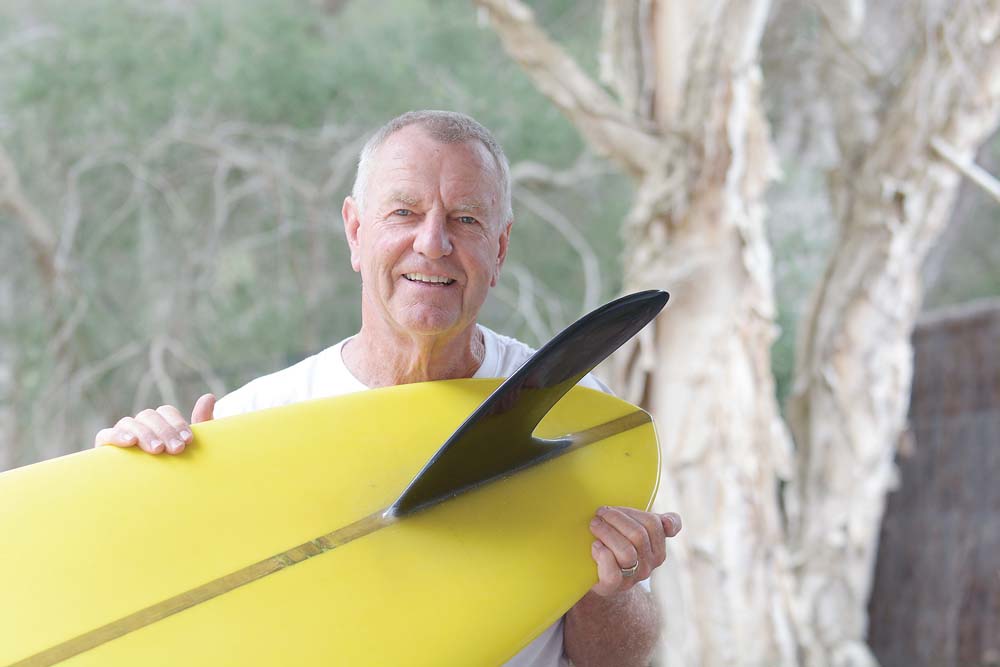
Mostly used to designing and liaising with clients over the shape and size of a custom surfboard, the two brothers are increasingly involved in restoring boards that have historical or sentimental value.
In some instances, surfboards have become family heirlooms.
One of the more interesting restoration jobs to come the Triggers’ way in recent months was brought in by their long time friend, former Peninsula Surf Centre proprietor, Ted Bainbridge.
When shown the board Bainbridge wanted to refurbish, both in looks and function, Phil Trigger’s advice was to “bin it”. Which was something Bainbridge contemplated as he passed a builder’s skip on his way home across the Mornington Peninsula from the Trigger brothers’ Point Leo base.
However, sentiment won out, and Bainbridge kept the board made more than 50 years previously by his older brother Austin, or Ocka.
Later that night Phil Trigger rethought his spur-of-the-moment advice and called Bainbridge the next day: “Bring Ocka’s board back Ted, we’ll give it a go.”
Ten years older than his younger brother, Austin “Ocka” Bainbridge heard the news about polyurethane blanks in 1963 and bought one home to be shaped and covered in fibreglass in the garden shed of their parents’ Noble Park home.
“Mum’s best dress making scissors got covered in resin during the process and there was hell to pay, [but] it was the best thing this stoked little gremmie had ever seen,” Ted remembers.
“Ocka’s okanui board was 9 foot 9 inches long, 23.5 inches wide and 3.5 inches thick. Initially I was not allowed to use it as the epoxy beast [Ocka’s first attempt at board making] was always available. But, gradually, I was given permission to give it a go, and I have fond memories of catching my first waves on it.
“The board then lost favour, but did get a colour change to blue at some stage, before being relegated to the top of the wood stack beside the shed.”
The board eventually made its way to the family’s Sorrento “holiday shack” before “languishing” for the past 30 years in Ted Bainbridge’s work shed at Rye.
After 56 years the board had yellowed with age and the fibreglass was delaminating, or lifting off the polyurethane core.
“It was basically unusable and despite numerous attempts, I could never quite take it to the tip,” Ted said.
He managed to break off the board’s tail while attempting to remove the original “D” fin, but was happy to see “crisp white foam”.
After sawing the board in half and contemplating replacing the rotted wooden stringer (running up the centre of the board for strength), he received a call from Phil Trigger: “Ted, I’ve been thinking about Austin’s old board. Bring it over and we’ll replace the stringer, glue the tail back on and see what Paul can shape out of it.
“Bring an old tyre inner tube to cut up into large rubber bands to hold the blank together when we glue-up the stringer.”
It all sounded so simple. What could go wrong?
“Without a doubt Ted’s brother’s old board is the most difficult restoration we have ever undertaken,” Paul Trigger said.
“In pulling out an accurate shape we had to lose a little of the old decayed foam with its partial coating of caramelised resin left behind when Ted skinned the board.
“This was particularly hard to remove and I resorted to using a sander then flaking it off with a mini surf planer.
“Phil has taken on hundreds of restorations and the secret is not to make them too perfect, but try and maintain the rich history the surfboard has for its owner.”
Paul Trigger suggested making a feature of the “1960s inferior foam” by lightly tinting the bottom to highlight inconsistencies, watermarks and scars accumulated over the years.
Ted Bainbridge saw the logic of making a watertight, useable board that embraced, rather than made apologies or tried to disguise its history.
“The end result is a 9 foot 8 inch by 21.5 inch modern take on the old clunker that it once was,” he said.
“Purists may think a board of that age should have its entire provenance retained in a restoration. I agree if it’s been made by one of our surfing legends, but for a backyard board with years of neglect, this makeover was the right thing.”
But does it surf?
“I’ve had a couple of waves on it at Rye and Shoreham. It has very little rocker and tends to track in a straight line, but I’ll get it worked out eventually,” Ted said.
“It’s a lovely feeling to paddle into waves on the board that gave me the initial surf stoke.”
Big brother Austin is “chuffed that his old creation has a new lease of life”.
First published in the Southern Peninsula News – 18 February 2020